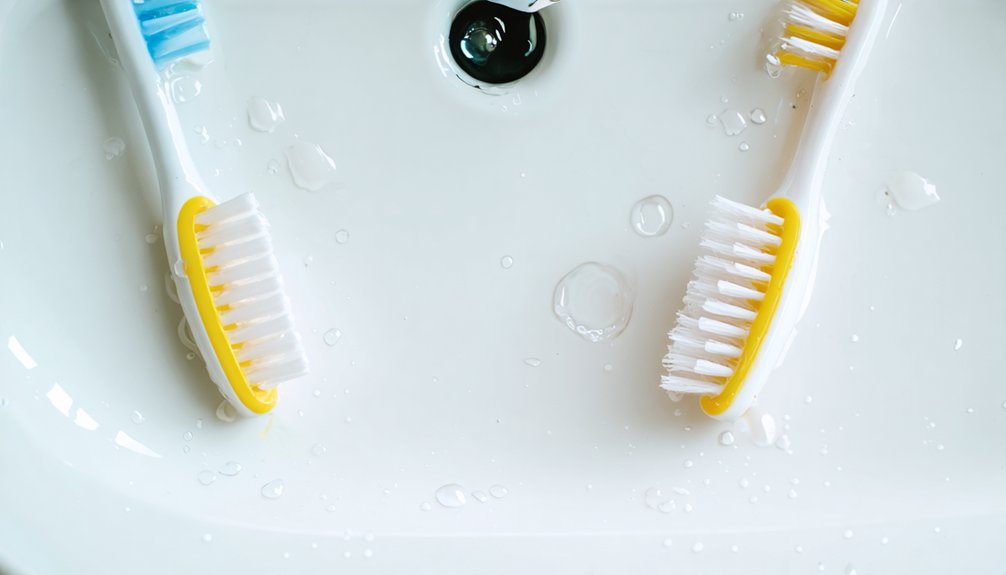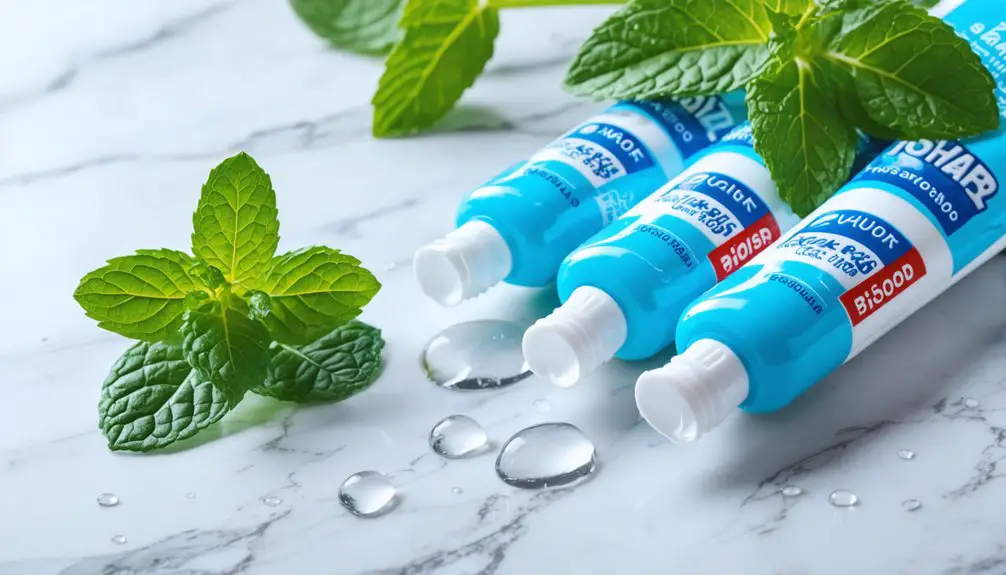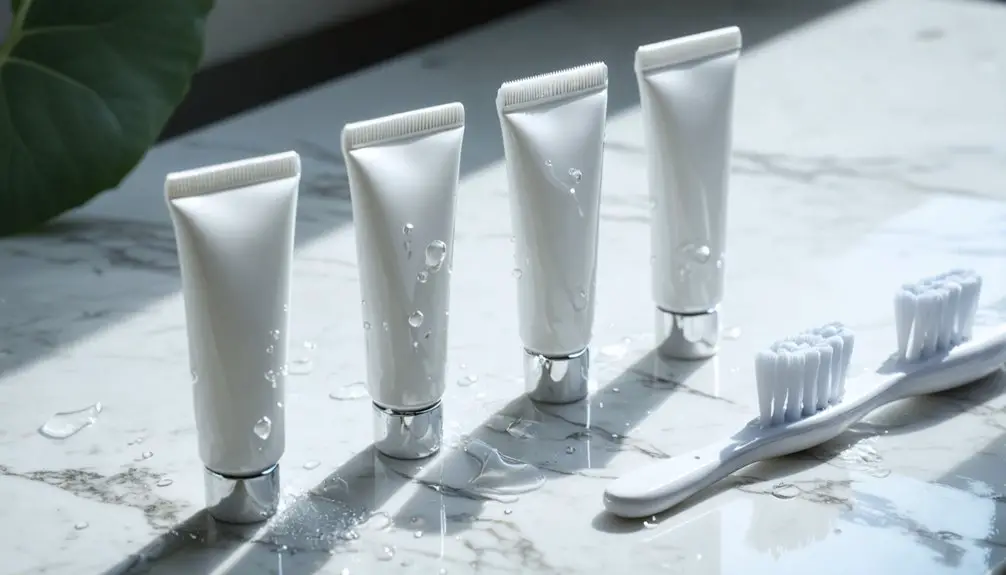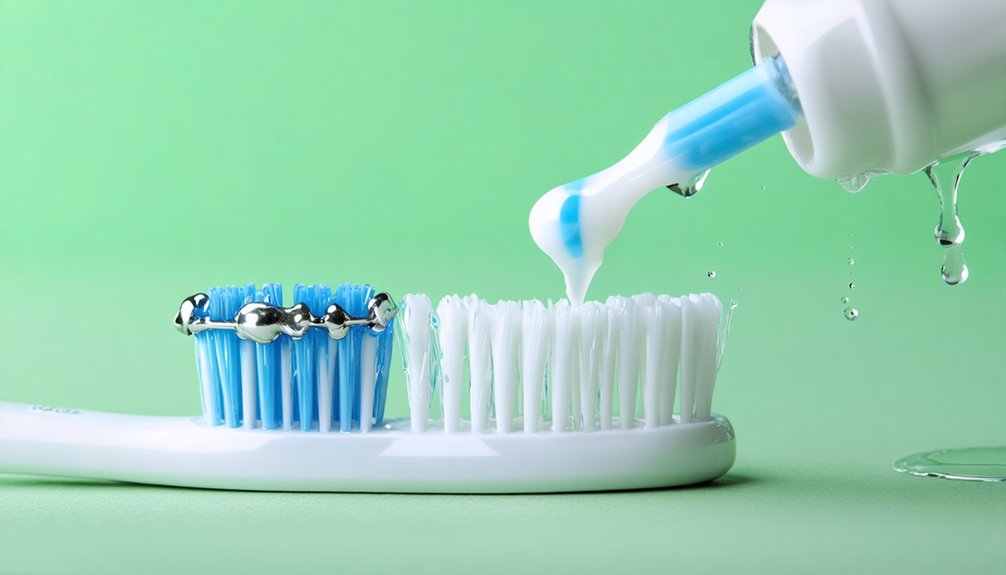Hydrogen peroxide whitening toothpaste offers you a scientifically-proven way to brighten your smile through gentle oxidation. It penetrates deep into your enamel to break down both surface and intrinsic stains, delivering visible results within 7 days when used properly. With ADA-approved concentrations of up to 3.5%, it’s safe for regular use and outperforms traditional whitening methods. For best results and safety, understanding the science and proper usage techniques will enhance your whitening journey.
Key Takeaways
- Hydrogen peroxide effectively breaks down both surface and deep stains by penetrating tooth enamel with active oxygen molecules.
- Scientific studies show hydrogen peroxide achieves superior whitening results compared to other over-the-counter whitening agents.
- Results become visible within 7 days and reach maximum effectiveness within 28 days of regular use.
- ADA-approved concentrations (up to 3.5%) provide safe and reliable whitening without risking tooth sensitivity or enamel damage.
- The dual action of cleaning and whitening makes it more efficient than using separate whitening treatments and regular toothpaste.
The Science Behind Hydrogen Peroxide Whitening
While many people know hydrogen peroxide whitens teeth, understanding its chemical mechanism reveals why it’s such an effective whitening agent. When hydrogen peroxide contacts your teeth, it breaks down into water and oxygen, triggering oxidative reactions that transform staining compounds. Research shows ADA-approved products provide the safest and most reliable whitening results.
The released oxygen molecules penetrate both your enamel and dentin layers, breaking down complex pigmented molecules into smaller, less visible forms. This process is enhanced by exposure to light and heat, which speeds up the breakdown of hydrogen peroxide.
During stain removal, hydrogen peroxide acts as a powerful oxidizing agent, chemically altering chromogens that cause discoloration. This process works on both surface stains from food and beverages, as well as deeper intrinsic staining.
Your saliva’s natural enzymes help accelerate this breakdown, while the peroxide’s antimicrobial properties simultaneously fight bacteria that could contribute to future staining.
Safety and Recommended Usage Guidelines
Understanding how hydrogen peroxide works for teeth whitening leads to the important matter of using it safely. To protect your dental health, follow established safety standards when using whitening toothpaste containing hydrogen peroxide. The ADA recommends concentrations no higher than 3.5% for over-the-counter products.
Regarding usage frequency, don’t use hydrogen peroxide whitening toothpaste daily, as this can lead to enamel erosion and increased sensitivity. Instead, limit use to a few times per week and dilute solutions when preparing home treatments. The whitening agent penetrates tooth enamel to effectively break down stains beneath the surface. Professional dental supervision is crucial since tooth sensitivity often occurs with regular use.
If you experience any discomfort, stop use immediately and consult your dentist. For best results and safety, choose ADA-approved products and maintain regular dental check-ups to monitor your oral health during whitening treatments.
Real Results: What to Expect
When using hydrogen peroxide whitening toothpaste, you’ll typically notice initial improvements within 7 days, with the most significant changes occurring during the first 28 days of use.
The whitening timeline shows that results tend to plateau after this initial period, making consistent use essential for maintaining your brighter smile. Studies show that hydrogen peroxide toothpaste achieves good effectiveness ratings comparable to conventional toothpastes. These products prove most successful at removing surface stains while being gentler on teeth than many alternatives.
While hydrogen peroxide toothpaste delivers good whitening results, it’s important to set realistic expectations. You’ll achieve visible improvements that surpass traditional toothpaste, though not as dramatic as professional treatments.
The peroxide works by penetrating the enamel to remove both surface and deeper stains, creating lasting effects. For ideal results, consider complementing your toothpaste with hydrogen peroxide whitening strips, which offer extended contact time and potentially stronger whitening effects due to higher peroxide concentrations.
How It Compares to Other Whitening Methods
Compared to other whitening methods, hydrogen peroxide stands out as the most effective over-the-counter whitening agent, achieving a significantly higher color difference (ΔE = 9.6) than alternatives like sodium bicarbonate or PAP.
Unlike abrasive agents that only remove surface stains, hydrogen peroxide’s chemical action penetrates deep into your enamel, breaking down both extrinsic and intrinsic stains.
You’ll notice faster results with hydrogen peroxide compared to carbamide peroxide, though the latter offers longer-lasting effects.
While abrasive whitening toothpastes rely on physical stain removal, hydrogen peroxide actually changes the natural color of your teeth through chemical bleaching.
For best results with minimal risks, you’ll want to choose products with appropriate peroxide concentrations – higher levels for professional treatments and lower, safer amounts in daily-use toothpaste. Modern dental techniques focus on minimally invasive approaches to protect enamel while achieving optimal whitening results.
Regular use can help maintain a brighter smile over time when following the manufacturer’s recommended application instructions.
Tips for Maximum Whitening Benefits
To maximize the whitening effects of hydrogen peroxide toothpaste, you’ll need to follow specific usage guidelines that balance effectiveness with safety.
Select a toothpaste with up to 3.5% hydrogen peroxide concentration and verify it’s ADA-approved for best results.
Maintain proper whitening frequency by brushing twice daily, limiting each session to two minutes. Don’t exceed recommended usage to protect your enamel. Higher concentrations above 6% are considered unsafe for consumers.
Creating a paste mixture with baking soda and peroxide can help tackle stubborn stains when used occasionally. If you experience sensitivity, switch to formulations containing desensitizing agents. Complement your whitening routine with regular flossing and professional cleanings.
For sustained results, avoid staining substances like coffee and tobacco.
Consider monthly touch-up treatments, and pair your whitening regimen with non-abrasive fluoride toothpaste to strengthen enamel.
Monitor for any adverse effects and consult your dentist if irritation persists.
Frequently Asked Questions
Can I Use Hydrogen Peroxide Whitening Toothpaste While Pregnant or Breastfeeding?
You shouldn’t use hydrogen peroxide whitening toothpaste during pregnancy or breastfeeding due to safety concerns. Choose peroxide-free alternatives designed for pregnancy, and consult your healthcare provider for specific recommendations.
Does Hydrogen Peroxide Whitening Toothpaste Work on Dental Crowns and Veneers?
No, hydrogen peroxide won’t whiten your crowns or veneers. For proper crown whitening and veneer care, you’ll need non-abrasive toothpaste instead, as whitening products can damage your dental restorations.
How Long Does Tooth Whitening Last After Stopping Hydrogen Peroxide Toothpaste?
Back to square one: Your whitening effects will fade within 1-6 weeks after stopping hydrogen peroxide toothpaste. Watch for tooth sensitivity if you’re considering frequent whitening treatments to maintain results.
Will Hydrogen Peroxide Whitening Toothpaste Remove Antibiotic Stains From Teeth?
You’ll see limited results using hydrogen peroxide toothpaste for antibiotic staining since these marks are deep within teeth. Professional teeth whitening treatments at higher concentrations may be more effective for your situation.
Can Children Use Hydrogen Peroxide Whitening Toothpaste Safely?
You shouldn’t give children hydrogen peroxide whitening toothpaste due to serious safety concerns. Wait until they’re at least 12-13, and consult your dentist for proper dosage recommendations and safer alternatives.
References
- https://ec.europa.eu/health/scientific_committees/opinions_layman/en/tooth-whiteners/l-3/4-tooth-whitening-treatment.htm
- https://pmc.ncbi.nlm.nih.gov/articles/PMC6232812/
- http://www.scielo.sa.cr/scielo.php?script=sci_arttext&pid=S2215-34112022000100067
- https://www.gentledental.com/resources/articles/hydrogen-peroxide-teeth-whitening
- https://pmc.ncbi.nlm.nih.gov/articles/PMC10474654/
- https://www.hollywoodwhitening.com/en/blog/hydrogen-peroxide-for-teeth-whitening-how-does-it-work/
- https://www.medicalnewstoday.com/articles/326148
- https://pmc.ncbi.nlm.nih.gov/articles/PMC4058574/
- https://ec.europa.eu/health/scientific_committees/opinions_layman/en/tooth-whiteners/l-3/3-home-tooth-whitening-dentist.htm
- https://www.trysnow.com/blogs/news/is-hydrogen-peroxide-safe-for-teeth



